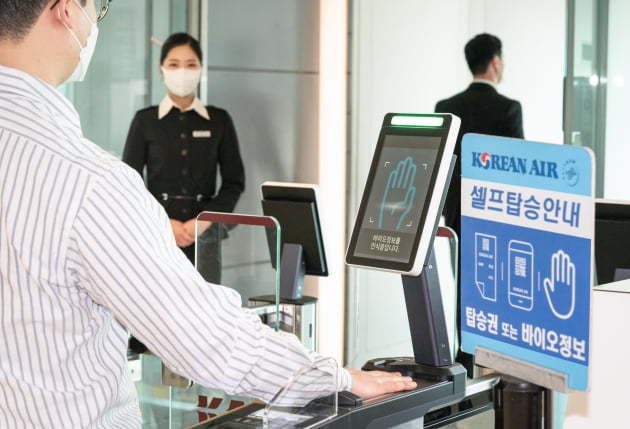 |
A Korean Air passenger scans his palm at a boarding gate. (Korean Air) |
Korean Air customers flying on domestic routes can now pass through the boarding gate empty handed -- as the airline has adopted palm vein scanning to verify passengers’ identities.
According to the air carrier on Tuesday, those aged above 7 with Korean nationality can register their biometric information at Korean Air kiosks in Gimpo International Airport’s departure area. Passengers who do so can simply scan their palms at the boarding gate without having to show their boarding passes.
The air carrier said it expects the new process to reduce waiting and boarding time for passengers, bolster security and reduce the risk of theft, loss or duplication of passes.
The service will be available at five boarding gates for domestic routes departing Gimpo. In August, the service will become available at Gimhae International Airport in Busan. Korean Air aims to expand the service to all gates at Gimpo by the year-end.
In recent years, scanning palm veins for identification verification has drawn attention. The system works by checking the unique variations of each individual’s vein thickness or shape, and is more accurate than palm print scanning. Experts say this is because people's veins stay the same even as they age.
At Gimpo and Jeju International Airports, palm vein identification verification scanners have been used at unmanned check-in points for 14 domestic routes, without having passengers hand in separate ID.
Korean credit card operator Lotte Card has operated its Hand Pay service in 2017, which allows identification verification and payment just by scanning their palm veins at some 90 Lotte brand shops including convenience stores, fast food chains and supermarkets.
The technology has evolved in recent years, no longer requiring the customer to even touch the scanner. Amazon has been developing a touchless scan system using computer vision and geometry technology to read anatomical characteristics including bones and cartilage.
By Kim Da-sol (
ddd@heraldcorp.com)








![[Today’s K-pop] Blackpink’s Jennie, Lisa invited to Coachella as solo acts](http://res.heraldm.com/phpwas/restmb_idxmake.php?idx=644&simg=/content/image/2024/11/21/20241121050099_0.jpg)